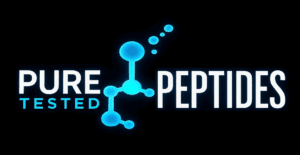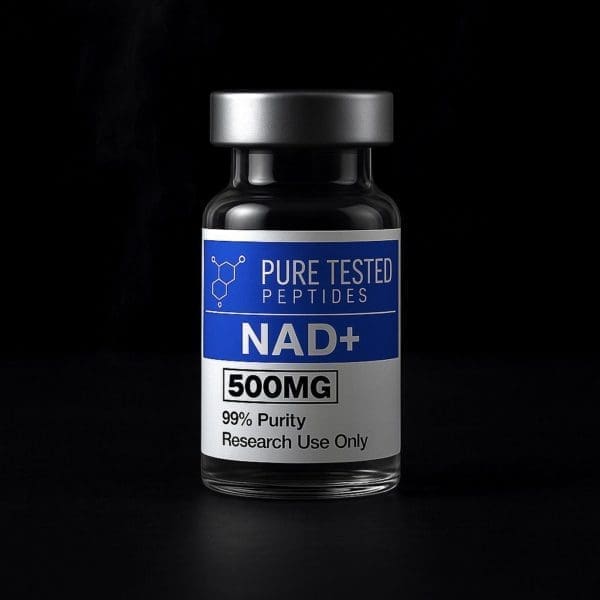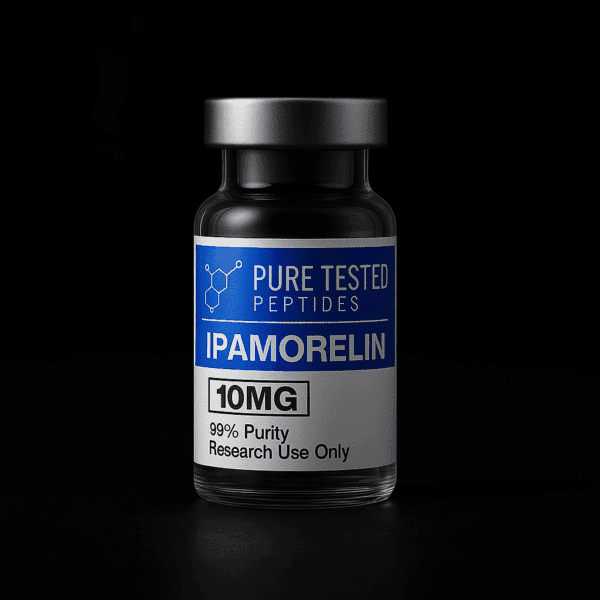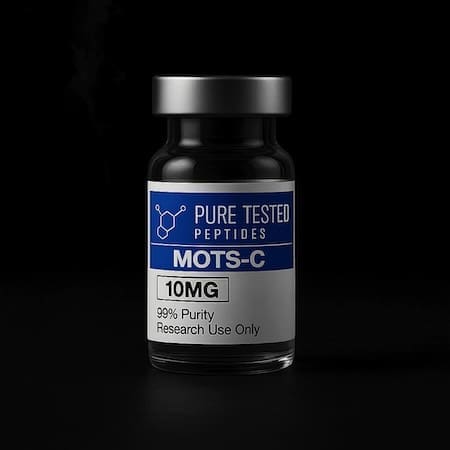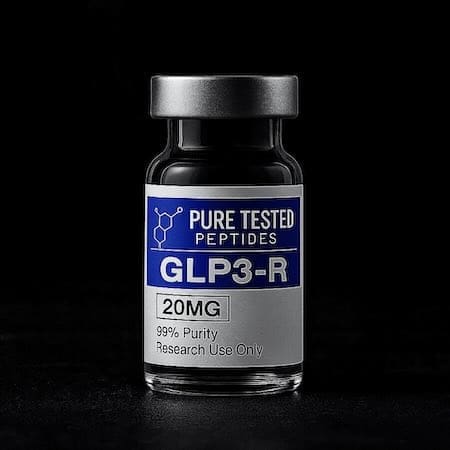NAD+ Research Overview & Where to Buy Peptides Online (Research-Only)
This page summarizes peer-reviewed mechanisms relevant to NAD+ (nicotinamide adenine dinucleotide). NAD+ is a central cellular coenzyme, not a peptide; it is included in our catalog for research applications only. All items referenced are sold strictly for laboratory use—not for human consumption.
What is NAD+? Core Roles in Cell Biology
Nicotinamide adenine dinucleotide (NAD+) cycles between oxidized (NAD+) and reduced (NADH) states to shuttle electrons in metabolism. Through this redox shuttling, NAD+ is indispensable for glycolysis, the TCA cycle, and mitochondrial oxidative phosphorylation—processes that collectively generate ATP. Beyond energy metabolism, NAD+ is a substrate for several enzyme families that shape genome maintenance and stress responses:
- PARPs use NAD+ to attach poly(ADP-ribose) chains during DNA-damage signaling, linking cellular NAD+ pools to genome integrity and repair dynamics.
- Sirtuins (NAD+-dependent deacetylases) remodel chromatin and metabolic programs; when NAD+ is abundant, sirtuin activity tends to favor oxidative metabolism and stress resilience pathways.
- CD38/CD157 and related ectoenzymes consume NAD+ to generate cyclic ADP-ribose, influencing calcium signaling and immunometabolism.
Cellular NAD+ is compartmentalized (cytosol, mitochondria, nucleus). Because mitochondrial inner membranes are impermeable to NAD(H), cells rely on malate–aspartate and glycerol-3-phosphate shuttles to relay reducing equivalents between compartments, while biosynthetic pathways (Preiss–Handler, de novo from tryptophan, and the salvage pathway via NAMPT) maintain total pools.
Why NAD+ Levels Matter in Experimental Systems
Multiple models report that NAD+ availability declines with cellular age, coinciding with changes in mitochondrial efficiency, redox balance, and DNA-repair capacity. In research settings, maintaining or restoring NAD+ pools has been associated with improved readouts of mitochondrial respiration, increased AMPK–PGC-1α activity, and enhanced stress-response gene expression in cells and murine tissues. These outcomes are model-dependent and hypothesis-generating, but they place NAD+ at the center of many longevity-adjacent experimental questions.
Common laboratory strategies to modulate NAD+ include precursor supplementation (e.g., NR or NMN feeding in rodents/cells), manipulation of salvage enzymes (overexpressing or inhibiting NAMPT), or direct provision of NAD+ in specific experimental contexts. The readouts typically include measurements of NAD+/NADH ratio, PARylation, sirtuin deacetylation marks, respiratory capacity (Seahorse), and transcriptomic shifts in oxidative and repair pathways.
Mechanistic Map: From NAD+ to Mitochondrial Performance
Conceptually, NAD+ ties together electron transfer and signaling:
- Redox Flux — NADH donates electrons to Complex I of the electron transport chain; adequate NAD+ helps sustain oxidative phosphorylation and ATP generation.
- Sirtuin Signaling — SIRT1/SIRT3 deacetylate metabolic enzymes and transcription factors (e.g., PGC-1α), promoting mitochondrial biogenesis and fatty-acid oxidation signatures in many models.
- DNA-Repair Coupling — PARP activation during damage responses consumes NAD+; excessive activation can deplete pools, prompting interest in balancing DNA repair with NAD+ homeostasis in cell culture experiments.
- Immunometabolic Crosstalk — CD38-driven NAD+ consumption has been implicated in immune-cell activation states and may influence inflammatory readouts in in vitro systems.
Related Research Lines in the PTP Catalog (Mitochondria & Metabolism)
Because NAD+ interfaces with mitochondrial function and energy balance, labs often study it alongside complementary research compounds that act on overlapping pathways. Below are popular items (images click through to their product pages) frequently explored in metabolism/mitochondria projects:
NAD+ 500 mg (Research Use)
Central redox coenzyme used in studies of mitochondrial respiration, sirtuin activity, and PARP-linked DNA repair. View NAD+ details.
Ipamorelin 10 mg
Growth-hormone secretagogue examined for its effects on GH/IGF-axis signaling in preclinical systems; often paired with metabolic readouts that also depend on cellular NAD+/NADH balance. View Ipamorelin.
MOTS-c 10 mg
Mitochondrial-derived peptide investigated for AMPK-linked metabolic reprogramming and exercise-responsive signaling—mechanisms that intersect with NAD+-dependent pathways in cell and murine models. View MOTS-c.
SLU-PP-332
ERR (α/β/γ) pan-agonist tool compound explored as an exercise-mimetic in preclinical studies; upregulates oxidative programs that are frequently quantified alongside NAD+-sensitive readouts (OXPHOS capacity, PGC-1α networks). View SLU-PP-332.
Popular Product Highlight: GLP3 Online
While GLP-3 research primarily targets incretin biology (GLP-1R, GIPR, GCGR agonism), many labs track mitochondrial and lipid-oxidation signatures that have conceptual ties to the NAD+ / sirtuin axis. For teams mapping endocrine–metabolic crosstalk with cellular energetics, GLP-3 is often profiled with respiration, AMPK, and transcriptional markers.
GLP3-R 20 mg — buy glp3 online
Triple-agonist research compound profiled in metabolic programs; popular among researchers building multivariate panels that also include mitochondrial and NAD+-related endpoints. View GLP3-R.
Experimental Design Notes (Research-Only)
- Measure compartments and ratios: Quantify total and compartmental NAD+/NADH and the NAD+/NADH ratio; pair with oxygen consumption rate (OCR) and extracellular acidification rate (ECAR) to contextualize redox changes.
- Track cofactor-dependent marks: Histone/TF acetylation states (sirtuin targets) and PARylation levels can triangulate whether altered readouts reflect redox versus signaling consumption of NAD+.
- Mind the sinks: High PARP or CD38 activity can drain NAD+; interpretations should incorporate damage and immune-activation markers.
- Pairing with metabolic tools: When co-studying NAD+ with MOTS-c or SLU-PP-332, align dosing and timing to expected kinetics of AMPK/ERR transcriptional programs, then capture multi-omic snapshots (transcripts + respiration + acetylation marks).
Catalog Navigation & Where to Buy Peptides Online
Explore all current research compounds at our catalog hub:
All Peptides for Sale.
For rapid access to the items discussed on this page, use the links above or visit the
Pure Tested Peptides homepage.
Every listing includes lot-specific testing details, storage, and handling notes for laboratory work.
All products referenced here—including NAD+, peptides, and blends—are sold for laboratory, research, and analytical purposes only.
They are not for human consumption, medical, or veterinary use. No statements herein make claims of therapeutic benefit.
Review all applicable regulations before ordering or using any research chemicals.
